The following components are necessary to write a feature article. The ministerial exam in Enriched English as a Second Language is to write a feature article.
A headline in a feature article is a concise and attention-grabbing title that captures the essence or main idea of the article. It is designed to quickly engage readers and give them a glimpse into what they can expect from the article.
Your headline comes at the top of your feature article. Here are some tips to write a good headline:
-
Keep it short and snappy:
Keep your headline concise and to the point. Use as few words as possible to convey the main idea, while still capturing the reader's interest and curiosity.
-
Use strong, active language:
Opt for strong verbs and active language that evoke emotion or create a sense of urgency. This helps to make the headline more dynamic and engaging.
-
Be specific:
Instead of using vague or generic terms, be specific and provide a unique angle or perspective on the topic. This helps to differentiate your headline from others and pique the reader's interest.
-
Get creative with wordplay or puns:
A clever play on words or a well-crafted pun can add an element of creativity and wit to your headline, making it memorable and eye-catching.
-
Use numbers that impress:
Incorporating numbers or statistics in your headline can make it more compelling and intriguing. People are often drawn to articles that promise a specific number of tips, insights, or surprising facts.
Keep in mind that while you should try to incorporate most of these tricks into your headline, it may not always be possible or logical to do so.
Here is a headline that could be appropriate for a feature article on the topic of mental illness.

-
Curiosity: it captivates readers with the phrase hidden battle, suggesting that there is more to the issue than meets the eye.
-
Strong and specific vocabulary: the attention-grabbing phrase shedding light implies that the article will bring awareness and understanding to the topic of mental illness among teenagers. It suggests that readers will gain valuable insights into the article, emphasizing the importance of addressing this issue.
-
Speaking to the audience: it speaks directly to the target audience of teenagers by addressing their unique experiences and challenges with mental illness. This personalizes the headline and makes it more relatable, increasing its appeal to teenagers.
A secondary headline is a brief and catchy phrase that appears below the main headline of a news article, designed to provide additional context or highlight an important point. It's like a subtitle – or key idea within the article – that can help grab your attention and understand the main message even faster.
Your secondary headline should be separated from your headline at the top. Here are some tips to write a good secondary headline:
-
Keep using strong vocabulary: Use strong and intriguing words to catch the readers’ attention and make them want to read more.
-
Complement the main headline: Your secondary headline should add value and provide additional information to support the main headline. It should highlight a key aspect that complements the main message.
-
Be clear and informative: Ensure that your secondary headline clarifies the topic matter and accurately captures the main idea or theme of the article. Avoid ambiguity and focus on providing a clear and concise snippet of what readers can expect to find in the article.
The secondary headline can be slightly longer than the headline as you are focusing the attention of your reader on a specific aspect you are about to explore.
Here’s a secondary headline that could complement the headline we had earlier: “The Hidden Battle: Shedding Light on Teenagers' Struggles with Mental Illness”

-
Complement the headline: This secondary headline highlights a significant problem: the insufficient availability of mental health resources specifically for teenagers. By including this element, it directly calls attention to a particular aspect of the larger mental health crisis, making it relevant and crucial to address.
-
Speaking with the audience: The secondary headline suggests that exploring the lack of access to mental health resources for teens will shed light on the severity of the problem. It implies that potential solutions or actions to address it can be uncovered, further emphasizing the importance of paying attention to this crisis.
-
Strong vocabulary: the word "crisis" captures attention and highlights the seriousness of the situation. It conveys that there is a pressing need to address the lack of access to mental health resources for teenagers.
A lead is the opening sentence or paragraph of a feature article, you can call it the introduction, that aims to keep the reader's attention and summarize the main idea or theme of the story in a concise and engaging manner. It includes the angle and controlling idea of your article.
You can write a lead in just about any way possible. The way it turns out depends on you, the writer. However, it is crucial to maintain your readers' attention by incorporating a clear angle and a well-defined controlling idea.
-
You have multiple ways to keep your readers’ attention:
Humour: Jokes and puns are an interesting way to attract attention, as they set a light tone for what is to come.
Anecdotes: Anecdotes help the reader visualize the issue through examples.
Description: A description of a situation, event, or feeling conveys a great amount of mental images.
Facts and/or statistics will add credibility, which will lead to interest.
Obviously, you can’t use all of these at the same time in your lead. Test things out to see which one fits your style.
-
The angle is given on the day of the exam. Take the time to understand the angle clearly. However, keep in mind that you have to rephrase the angle, not copy-paste it to your text.
The controlling idea, also known as the main point or central theme of a feature article, is crucial in the lead because it guides the direction of the entire piece, determines the focus and scope of the article, and helps captivate the reader's interest from the beginning.
To continue after the headline and secondary headline, this could be an appropriate lead:
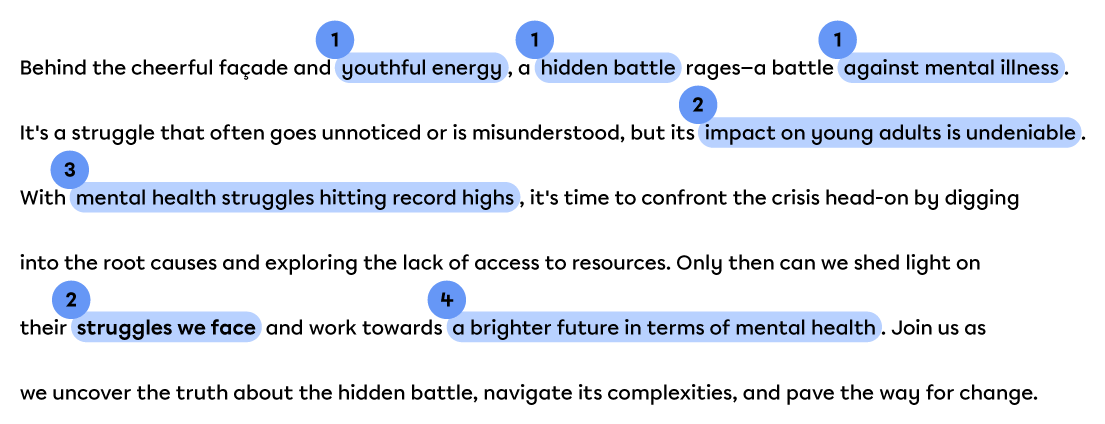
There are several reasons why this lead is effective:
-
Captivating language: The lead immediately captures the attention of young adults with phrases like hidden battle and youthful energy. It hooks the reader and makes them curious to learn more about the topic.
-
Relatable tone: It acknowledges and speaks directly to young adults, referring to the struggles we face. This personal approach makes the topic feel relevant and relatable to the target audience.
-
Identifying the issue: The lead concisely addresses the importance of the topic and its impact on young adults by stating that mental health struggles are hitting record highs. It emphasizes the significance of understanding and addressing the crisis, drawing the audience in with a sense of urgency.
-
Focus on exploration and change: It sets the stage for an investigative journey by highlighting the need to uncover the truth, navigate complexities, and pave the way for change. This emphasis on exploration and proactive action appeals to young adults who are passionate about making a difference.
Overall, the lead grabs young adults' attention, communicates the relevance of the topic, and engages them by presenting a call to action for addressing mental health issues.
The body of a feature article is the main section of the article that contains the in-depth exploration and development of the story.
You are the one who determines the way your article is structured. The information found in the feature can be organized in many ways. Here are some examples:
-
Cause and effect: information is presented by describing the cause of an issue and providing context (important events and players) and then showing its effect on the involved people, environment, businesses, etc…
-
Problem-solution: information is presented by describing a problem within a context and ending with a possible solution.
-
General to specific: information is presented from a wide context to more specific points of the issue.
-
Chronologically: information is presented through time.
-
Logically: any other form which is logical works, as long as it is clear and coherent for the reader.
The body of a feature article should/can be written in many paragraphs, their length isn’t that important as long as you explore your idea correctly. Make sure to organize your text with the appropriate transition words.
Here are three paragraphs, using the problem-solution method, that could continue our feature article on mental health. In bold font, you will notice parts that contribute to identifying the problem, and proposing a solution.
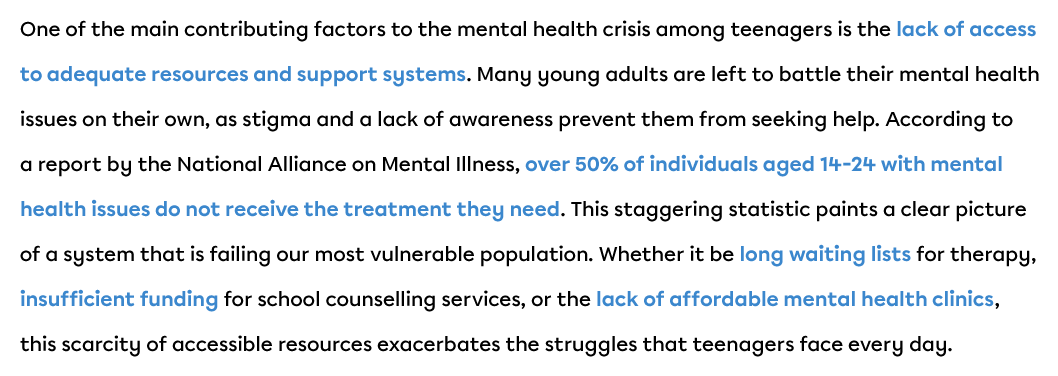
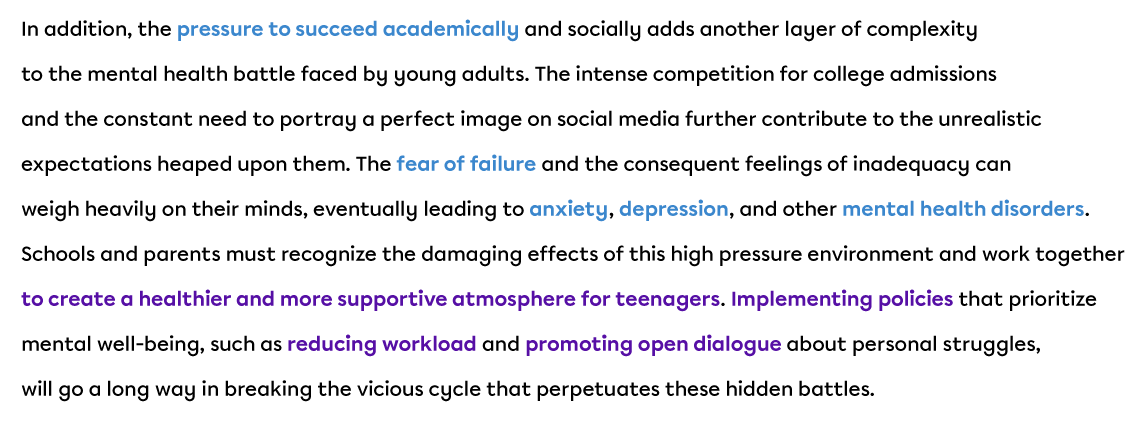
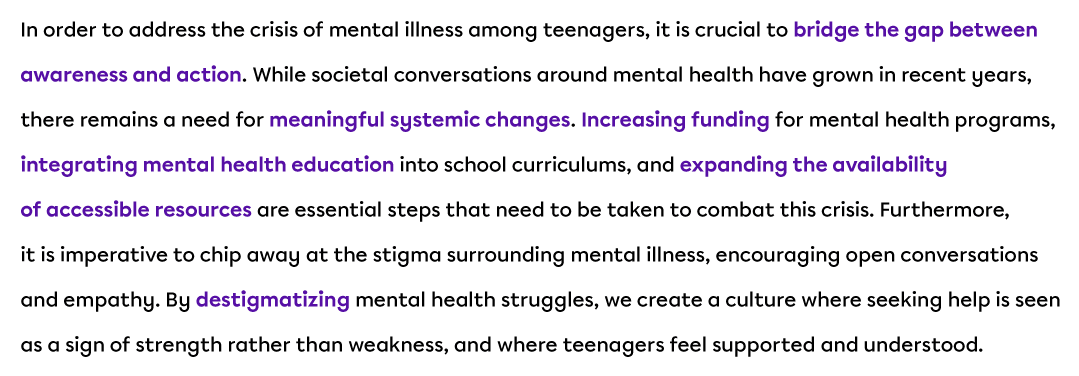
Here are some of the reasons why these paragraphs can be effective:
-
The body paragraphs effectively present the issue of the lack of access to mental health resources for teenagers, using strong evidence and concrete examples to support their claims. This includes statistics on untreated mental health issues, the pressure to excel academically and socially, and the scarcity of resources for young adults.
-
The body paragraphs provide tangible solutions and a call to action, suggesting specific steps to address the mental health crisis. These include increasing funding for mental health programs, integrating mental health education in schools, and promoting destigmatization efforts. By offering actionable recommendations, the article empowers readers to consider their role in addressing and improving the mental well-being of young adults.
The close in a feature article refers to the ending of the article. It is the final paragraph or section where the writer wraps up the main points, reiterates the key ideas, and leaves the reader with a strong lasting impression.
Here are some tips to write an effective close:
-
Recapitulate your main points: In the close, it is essential to rephrase the main points presented throughout the feature article. Summarize the key takeaways of your article in a concise and clear manner. This helps reinforce the main message and ensures that readers leave with a strong understanding of your feature's central theme.
-
Leave a lasting impression: The close is the final opportunity to make an impact on your readers. Consider ending with a thought-provoking statement, an emotional anecdote, or a compelling quote that relates to your article's subject matter. This helps leave a lasting impression on your readers' minds and encourages them to reflect on the issues presented in your piece long after they have finished reading.
-
Provide a call to action or a future outlook: A great close goes beyond summarizing the content; it also engages the reader on a deeper level. Consider providing a call to action that challenges readers to take specific steps or encourages them to get involved in addressing the topic discussed in your article. Alternatively, offer a future outlook or suggest potential advancements or solutions related to the theme of your feature.
Here’s a potential close to the feature article on mental illness. In different colours, you will notice parts that summarize the main points and leave a lasting impression.
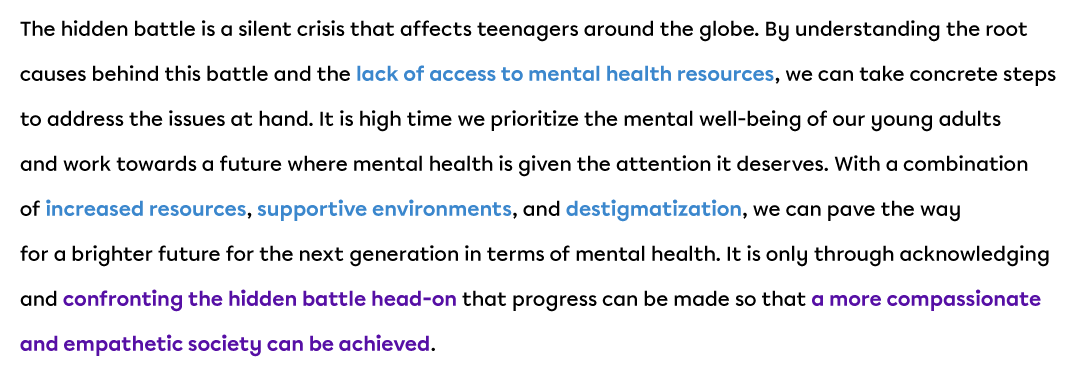
Here are a few reasons why this close can be effective:
-
The close effectively summarizes the main arguments and takeaways of the article by reiterating the central theme of the hidden battle and its impact on teenagers worldwide. This recap helps reinforce the main message and ensures that readers grasp the significance of the issue.
-
By emphasizing concrete steps to address the problems at hand, the close inspires readers to take action and creates a sense of agency. The mention of increased resources, supportive environments, and destigmatization efforts offers tangible solutions and encourages readers to consider their role in creating positive change.
-
The close concludes with a powerful and aspirational note, highlighting the importance of prioritizing mental well-being and envisioning a brighter future. This optimistic outlook leaves the reader with a sense of hope and possibility, motivating them to consider the broader impact and significance of the hidden battle on society as a whole.
You will be required to include at least 2 additional components in your feature article.
A quotation is a direct or indirect expression of someone's words, thoughts, or opinions, typically cited or referenced for accuracy and credibility. It serves as evidence or support in journalism, literature, or academic writing, providing insight or capturing the essence of a person's statement or ideas.
You’re required to include at least one quotation in your feature article, so use some but sparingly.
The easiest way to access potential quotes will be in your preparation booklet for the ministerial exam. Your goal is to select appropriate passages that could serve you. Be sure to cite appropriately in order to give credit. This may come before or after quotation marks (“”).
Sarah Lewis, a teacher at Alloprof, said in a recent article about mental health issues that, "Mental health issues among teens are on the rise, and the lack of access to resources is exacerbating the problem. We urgently need more funding and support for mental health services targeted specifically towards teenagers."
A quotation can be indirect. In such a case, you paraphrase the expert’s words. Just like a direct quote, you must acknowledge the expert from whom the idea has been taken.
Sarah Lewis, a teacher at Alloprof, maintains the idea that the rise in mental health issues among teens is aggravated by the insufficient access to resources. Dr. Lewis highlights the urgent need for increased funding and support for mental health services that specifically cater to teenagers.
A pull-quote is a brief passage or quotation taken from the text that is highlighted and visually emphasized within the content to grab the reader's attention. It is typically displayed in a larger font size, placed in quotation marks, and sometimes accompanied by decorative elements or a distinctive layout.

A sidebar is a supplementary piece of content or information that accompanies and complements the main article or text in a publication. It is usually located adjacent to the main text, often presented in a separate column or box, and offers additional context, related facts, anecdotes, or images that expand on the main topic or provide alternative perspectives.
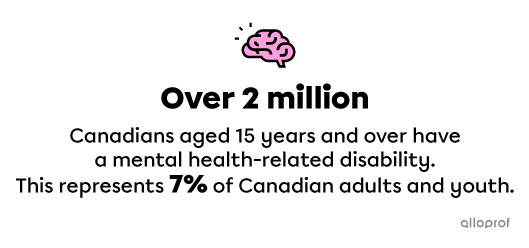
An image with caption refers to a visual element, typically a photograph or illustration, accompanied by a brief description or explanation located near or beneath it. The caption provides essential information about the image, such as identifying individuals, locations, or events captured in the picture, or offering additional context or insight related to the article's content.
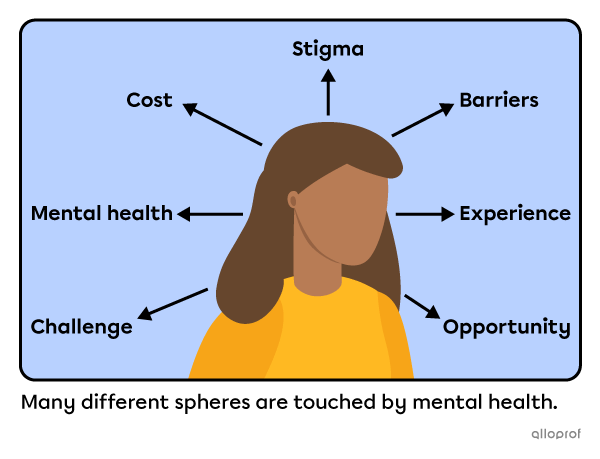
The Hidden Battle: Shedding Light on Teenagers' Struggles with Mental Illness
Exploring the Lack of Access to Mental Health Resources: Teens’ Only Way to Address the Crisis
Behind the cheerful façade and youthful energy, a hidden battle rages—a battle against mental illness. It's a struggle that often goes unnoticed or misunderstood, but its impact on young adults is undeniable. With mental health struggles hitting record highs, it's time to confront the crisis head-on by digging into the root causes and exploring the lack of access to resources. Only then can we shed light on the struggles we face and work towards a brighter, mentally healthier future. Join us as we uncover the truth about the hidden battle, navigate its complexities, and pave the way for change.
One of the main contributing factors to the mental health crisis among teenagers is the lack of access to adequate resources and support systems. Many young adults are left to battle their mental health issues on their own, as stigma and a lack of awareness prevent them from seeking help. According to a report by the National Alliance on Mental Illness, over 50% of individuals aged 14-24 with mental health issues do not receive the treatment they need. This staggering statistic paints a clear picture of a system that is failing our most vulnerable population. Whether it be long waiting lists for therapy, insufficient funding for school counselling services, or the lack of affordable mental health clinics, this scarcity of accessible resources exacerbates the struggles that teenagers face every day.
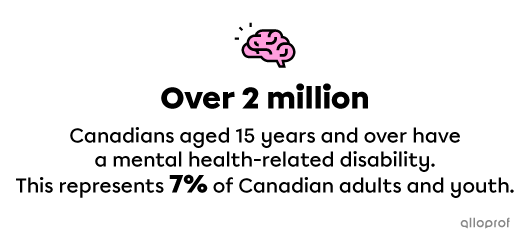
In addition, the pressure to succeed academically and socially adds another layer of complexity to the mental health battle faced by young adults. The intense competition for college admissions and the constant need to portray a perfect image on social media further contribute to the unrealistic expectations heaped upon them. The fear of failure and the consequent feelings of inadequacy can weigh heavily on their minds, eventually leading to anxiety, depression, and other mental health disorders. Schools and parents must recognize the damaging effects of this high pressure environment and work together to create a healthier and more supportive atmosphere for teenagers. Implementing policies that prioritize mental well-being, such as reducing workload and promoting open dialogue about personal struggles, will go a long way in breaking the vicious cycle that perpetuates these hidden battles.
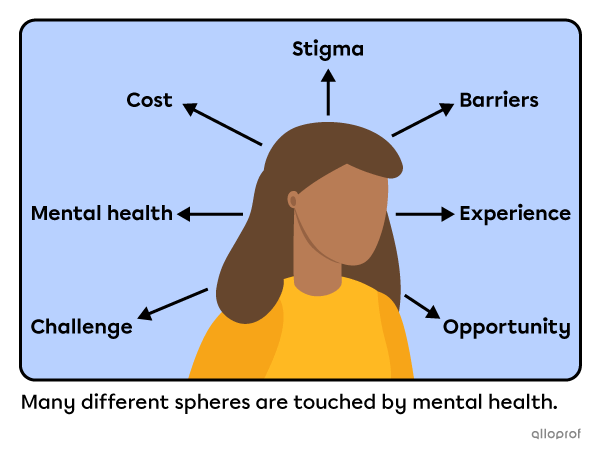
In order to address the crisis of mental illness among teenagers, it is crucial to bridge the gap between awareness and action. While societal conversations around mental health have grown in recent years, there remains a need for meaningful systemic changes. Increasing funding for mental health programs, integrating mental health education into school curriculums, and expanding the availability of accessible resources are essential steps that need to be taken to combat this crisis. Furthermore, it is imperative to chip away at the stigma surrounding mental illness, encouraging open conversations and empathy. By destigmatizing mental health struggles, we create a culture where seeking help is seen as a sign of strength rather than weakness, and where teenagers feel supported and understood.
The hidden battle is a silent crisis that affects teenagers around the globe. By understanding the root causes behind this battle and the lack of access to mental health resources, we can take concrete steps to address the issues at hand. It is high time we prioritize the mental well-being of our young adults and work towards a future where mental health is given the attention it deserves. With a combination of increased resources, supportive environments, and destigmatization , we can pave the way for a brighter future for the next generation in terms of mental health. It is only through acknowledging and confronting the hidden battle head-on that progress can be made so that a more compassionate and empathetic society can be achieved.